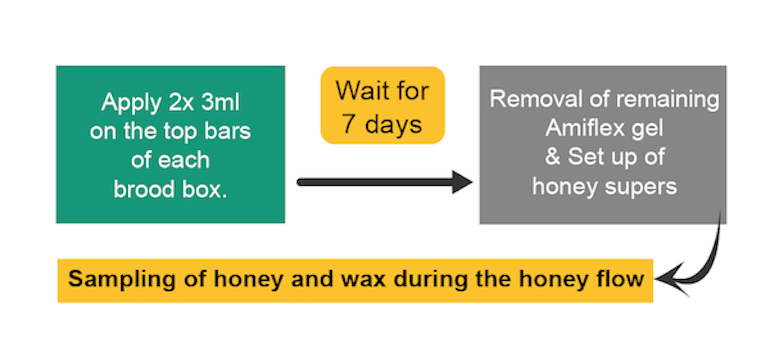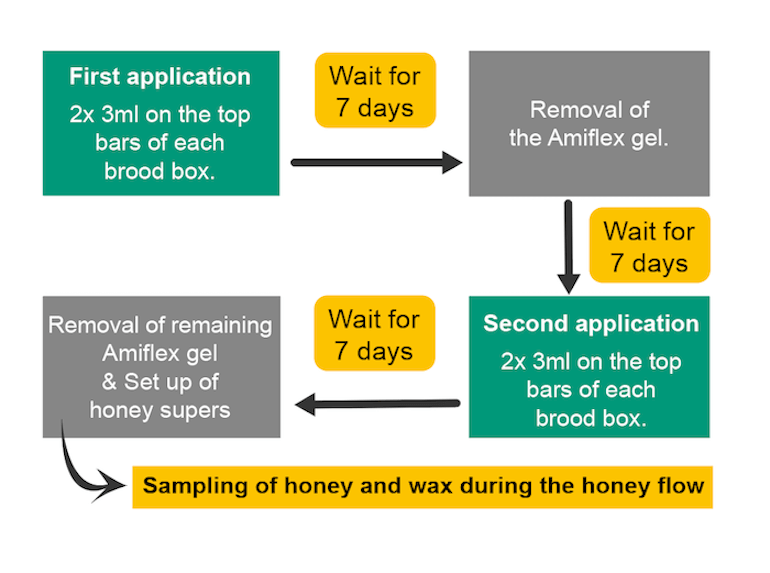 by Véto-pharma
by Véto-pharma When developing Amiflex, our mission included creating an amitraz-based flash treatment that would be safe for bees and hive products, such as honey and wax. Our goal was to formulate a treatment that not only complies with maximum residue limits but is also gentle on the bees.
This involved optimizing the dosage per application and determining the maximum number of applications allowable per year. Throughout this process, we closely monitored the residues in honey and wax to ensure they remained within the thresholds defined by the EPA. Additionally, we assessed the product’s tolerance by the colony to confirm its overall safety.
Until recently, there was no legal way to treat your hives with amitraz as a flash treatment in the USA. Despite this, the beekeeping industry has expressed a significant need for such treatments, leading many beekeepers to use amitraz-based products intended for cattle and other species. This approach, however, is not only illegal but also poses several risks:
“The pesticides involved were primarily Bovitraz and Taktic, which contain the active ingredient amitraz in a concentrated form (12.5%) that renders it a cancelled and unregistered pesticide. Amitraz is an acaricide that is registered in the United States to control varroa mites in honeybee colonies at a much lower concentration (3.33%) than the smuggled product. […] In addition to posing risks to the bee population, misuse of amitraz-containing products in beehives can result in exposures that could cause neurological effects and reproductive effects in humans from consumption of contaminated honey.”
When opting for chemical miticides, it’s crucial to use treatments specifically tested for honey bees. This ensures that the treatments have undergone clinical studies to assess residue accumulation in hive products like honey.
In this context, we’d like to share some study results demonstrating how well Amiflex is tolerated by honey bee colonies and the levels of residues detected in honey and beeswax after its application as a varroa treatment.
Varroa treatments, while targeting mites, inevitably come into contact with honey bees. To ensure these treatments don’t harm the bees, toxicity studies are essential before any varroa treatment is authorized for use.
In 2021, a clinical field study in France investigated the tolerance of honey bee colonies to Amiflex. The study applied Amiflex to three groups of colonies, testing both Dadant and Langstroth hive types. It also varied the dosage in Dadant hives between the standard label dosage and double that amount.
The study found no significant differences across the groups in key indicators: bee population size, number of brood cells, quantity of storage cells, and worker bee mortality (measured via dead-bee traps).
The study report concludes, “Amiflex® does not negatively impact colony regarding bee population, brood quantity, honey store quantity and bee mortality during the different scenario labelled.”
Residue studies are crucial to confirm that the recommended dosage of a varroa treatment like Amiflex does not lead to excessive residues in honey or wax. In the United States, the established tolerance thresholds for amitraz are 0.2 ppm (200 ppb) in honey and 9 ppm in wax.
In 2021, clinical field studies in France analyzed honey and wax samples from Dadant and Langstroth colonies treated with Amiflex. These samples were collected during the subsequent spring honey flow. Honey supers were installed only after the completion of the Amiflex treatment and the removal of all product residues (gel), following the label instructions.
From 15 colonies, 33 honey samples were collected during this period after a single Amiflex application (refer to illustration 1).

None of the honey samples exceeded the Maximum Residue Limit (MRL) of 0.2 ppm for amitraz and its metabolites. All samples were tested below the Lower Limit Of Quantification (LLOQ = 40.98 µg/kg) for amitraz in honey.
Wax samples from the same period also showed significantly lower concentrations than the MRL threshold of 9 mg/kg for amitraz in wax, recording levels at 0.28 ppm and 0.29 ppm (1 ppm =1 mg/kg).
An additional study involving 22 colonies exposed to two consecutive Amiflex applications before the spring honey flow yielded similar results

None of these honey samples exceeded the MRL for amitraz and its metabolites. Of these, 68% (15 out of 22 samples) were below the LLOQ for amitraz in honey. The remaining 7 samples were all tested below 50 µg/kg.
The wax samples from these colonies also remained well below the MRL, with levels of 0.27 ppm and 0.8 ppm.
The study results conclusively demonstrate that Amiflex treatment is safe and does not result in increased residues of amitraz or its metabolites in honey or wax beyond established thresholds. With Amiflex, beekeepers can confidently treat their colonies prior to an upcoming honey flow* without compromising the quality of their honey.
*It is essential to follow the product label guidelines and remove the Amiflex gel at the end of the 7-day application period, prior to installing honey supers on the hives. Compliance with these instructions ensures the safety and efficacy of the treatment.
Disclaimer: It’s important to note that while the results with Amiflex are positive, this does not imply that it can be used while honey supers are on the hives. Most of mite treatments, including Amiflex, should be administered without honey supers in place. This practice is essential to guarantee the quality of honey for human consumption.
Amiflex® is registered as a “Restricted Use Pesticide” (RUP). This means that its application is limited to certified applicators who have completed specialized training and are licensed by the state or federal government. The RUP status ensures the safe and effective use of these pesticides. If you’re interested in learning more about pesticide safety regulations and certification programs in your state, the EPA provides a comprehensive list of state pesticide safety education programs on their website. You can find more information here: https://www.epa.gov/pesticide-worker-safety/how-get-certified-pesticide-applicator and here https://www.epa.gov/pesticide-worker-safety/pesticide-safety-education-programs-0
1- Mullin CA, Chen J, Fine JD, Frazier MT, Frazier JL. The formulation makes the honey bee poison. Pestic Biochem Physiol. 2015 May;120:27-35. doi: 10.1016/j.pestbp.2014.12.026. Epub 2015 Jan 5. PMID: 25987217.
AFX-12-US-N01-05/23
Join the Véto-pharma community and receive our quarterly newsletter as well as our occasional beekeeping news. You can unsubscribe at any time if our content does not suit you, and your data will never be transferred to a third party!
© 2019-2025, Véto-pharma. All rights reserved